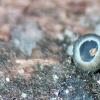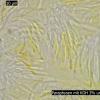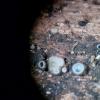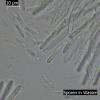
16-11-2025 21:09
 Robin Isaksson
Robin Isaksson
Anyone recognize this acc. to pictures.? Found on

14-11-2025 16:26
 Marian Jagers
Marian Jagers
Hello everyone, On dead wood of Cytisus scoparius

15-11-2025 23:22
Mario FilippaHello,this is what I think to be Hymenoscyphus mac

15-11-2025 20:25
 Riet van Oosten
Riet van Oosten
Hello, Found by Laurens van der Linde, Nov. 2025

14-11-2025 18:31
 Lothar Krieglsteiner
Lothar Krieglsteiner
Hello,can somebody provide me with a file of:Rothe

12-11-2025 09:25
 Viktorie Halasu
Viktorie Halasu
Hello, I need help with a pale terrestric Pseudom

11-11-2025 20:16
Bohan JiaHi, lastly I have found these tiny yellow decayin

09-11-2025 13:20
Hello.A tiny ascomycete, appearing as erupting gra
I found this Mollisia on 12.04.2023 on an approx. 20mm thick, partly debarked branch of Betula.
The branch had fallen off quite freshly.
Apothecia ca. 0.5 -1mm, max 1.5mm diameter, with in my opinion slightly felty outside. Inside, light, steel-grey/blue.
Asci ca. 45-50 x 5-8 ym, IKL+bb, hooks - (I think I did not see any).
Paraphyses positive with KOH 3%, partly still with yellow content, partly also in the preparation.
Marginal hairs multicellular.
Spores 8-9 x 2,4-3ym, the problem is that I did not find any free spores.
What is your opinion? I had toyed with the idea of M._olivascens/ M._perelegans, but have no experience with the species. :-)
Many thanks in advance.
Kind regards
Dirk

in my opinion this is not M. olilvascens which has larger apothecia with more pronounced longer haiirs (it mainly grows on thick Quercus logs).
Your specimen should belong in the complex around M. fusca, but for typical M. fusca the spores are somewhat too small and too poor of oil. With the key of Andreas Gminder I come to M. "pyrenopezizoides" or to M. "conifericola". A problem: both are provisional taxa not yet published. Perhaps Andreas can say more?
Best regards, Lothar

Thank you very much for your exciting answers.
The apos really don't seem to be properly ripe, as I didn't see any free spores.
The immature asci I measured were all no longer than 50 ym long and about 6-7ym wide.
I saw thick-walled hyphae, but due to lack of experience I did not attach any great importance to them and did not photograph them.
On the macro picture through the stereo loupe I think I see dark subiculum.
The thing with the hooks is not always so easy. :-), but I am attaching a picture.
Greetings Dirk


Who made the new combination Mollisia scopiformis? (I guess the answer should be found in mentioned Boletus paper).
Regards,
Bernard


Eine deutsche Version würde genügen, wenn möglich.
Grüsse,
Bernard

For the german version from Mollisia scopiformis follow this link:
https://asco-sonneberg.de/pages/ueberblick/artikel-i.-wagner.php
Greetings
Ingo W

Bernard
One/two apos have survived the post-ripening, or have grown back and also formed spores.
Spores [95% - 22 - QPr - v - H2O(nat) ]
= 11 - 12,8 - 14,5 x 2,3 - 2,8 - 3,4 µm
OCI= 1-2, partly with larger droplets.
Anchor hyphae or subiculum abundant.
I think this could already represent Mollisa_fusca or?
And again many many thanks for your help, the exciting discussions and answers.
Best regards
Dirk












